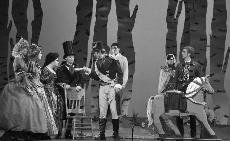
(Lawrence University Department of Theater Arts)
This weekend, Halloween revelry did not only manifest itself in extravagant costumes and bizarre character interactions. If you attended the Lawrence University theater production of “Into the Woods” last Thursday, Friday or Saturday, you may have seen Little Red Riding Hood cajoling Jack of beanstalk fame into stealing a magic harp or Cinderella’s and Rapunzel’s princes seeking out Sleeping Beauty and Snow White instead.
Sondheim’s über-fairytale-parody was played by two casts to four audiences. I saw the Friday night production, so this article mostly regards that performance, but the word around campus is that the Thursday/Saturday matinee cast also performed admirably.
The plot of “Into the Woods” is unavoidably convoluted to some degree; because the show is a mash-up of several renowned fairytales into one subversive near-three-hour musical, things tend to get confusing.
Basically, the Baker and his Wife seek to have a child, and are besotted by the machinations of the Witch as they go “into the woods” to acquire four objects that the Witch demands. These are Rapunzel’s hair, Red Riding Hood’s cloak, Cinderella’s slipper and Jack’s beloved cow, Milky-White. Hilarity ensues, and all ends happily ever after – at least in the first act.
Subverting the lovely “fairy-tale ending” by deploying it halfway through the show, Sondheim has crafted a scenario where everything decays post-resolution. Examining the common occurrence of unsolved plot points and auxiliary characters neglected in the conclusion, Act Two finds Jack’s giant’s wife returning to wreak havoc on the characters after the ever-after. The fabled heroes are shaken from their closed-cover stasis and must work to survive.
Now, regarding the performance. The music for “Into the Woods” is perhaps not the most vocally complex music some vocal performance students have encountered, but the actors’ musical performances were powerful and nuanced at their best; some ensemble numbers demanded precision that the cast was more than capable of providing.
Associate Professor of Music and Associate Director of Choral Studies Philip Swan’s pit orchestra may not have seemed overtly present to an untrained listener, but deftly provided those on stage with the spotlight, and provided a strong aural foundation for the show. Considering the demanding nature of the performance on the musicians – a total of 12 hours of near-constant playing in one weekend – their contribution may have been one of the most taxing to complete deftly.
The actors are, of course, the focus of any stage production, and their talents were where “Into the Woods” triumphed most. The Friday night leads were spot-on, particularly in the more emotionally-rocky second act. Brian Acker’s Jack and Evan Bravos’s Baker showed extreme depth and dynamism, and were laudable in their later scenes together.
Katie Cravens displayed a sprightly, optimistic, yet ever-maturing interpretation of Red Riding Hood while Amanda Ketchpaw gave the Baker’s Wife a matronly glow and a fiery spark. Katy Harth’s Witch was an antagonist with both a broken heart and pain to spare. Finally, Rachel Marschke played the somewhat statically written Cinderella with grace.
Given the multiple storylines and large cast, this by no means captures all of the impressive performances on display during the show; many of the more minor characters stood out as well, giving their roles an impressive range. For example, the princes’ ridiculous hopping around the stage never failed to garner laughs from the audience, but the two main princes added some nice depth to their roles during their songs.
Additionally, the Mysterious Man’s repeated abrupt appearances in the woods were consistently successful throughout Act One. Zach Garcia’s ability to expand the simple humor of someone constantly appearing out of nowhere into a silly doddering old man was extremely successful. He was a hilarious caricature of geriatrics, and ably confused the trope of the magical hermit.
“Into the Woods” was an exercise in theatrical well-roundedness, and the cast and crew rose admirably to the challenge.
(Lawrence University Department of Theater Arts)
